#Archaeology finds
Explore tagged Tumblr posts
Text

Missing Head of Ancient Greek Statue Unearthed After 2,100 Years!
Unveiling the mysteries of the ancient world often yields remarkable discoveries, yet few are as captivating as the recent unearthing of the head of Hygieia, the Greek goddess of health and hygiene, in Laodicea, Turkey. This 2,100-year-old artifact not only exemplifies the sophisticated artistry of ancient Greece but also deepens our understanding of their cultural and religious practices.
Find out more as the archaeologists explore the significance of this extraordinary find and its implications for the study of classical antiquity.
Read more at My Modern Met.
https://mymodernmet.com/hygieia-greek-statue/
#ancient history#ancient world#ancient art#ancient sculptures#Greek Mythology#Ancient Greek Goddess#Hygieia#Turkey#Laodicea#ancient artefacts#ancient craft#classical antiquity#Archaeology#Ancient Greek#Greek Culture#Archaeology finds
5 notes
·
View notes
Text
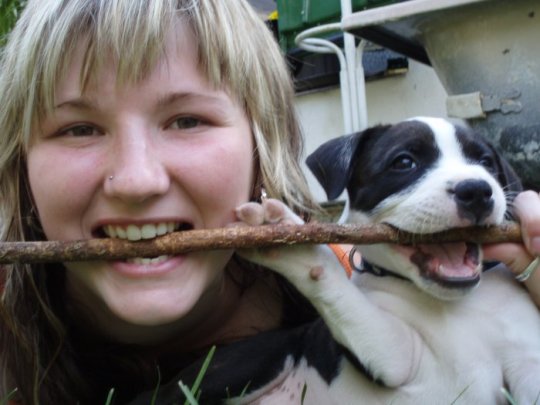

baby, 2007
#find#upload#dog#puppy#fetch#czech republic#czechia#2007#flickr#digicam#flickr finds#internet archaeology#rajce.net
2K notes
·
View notes
Text
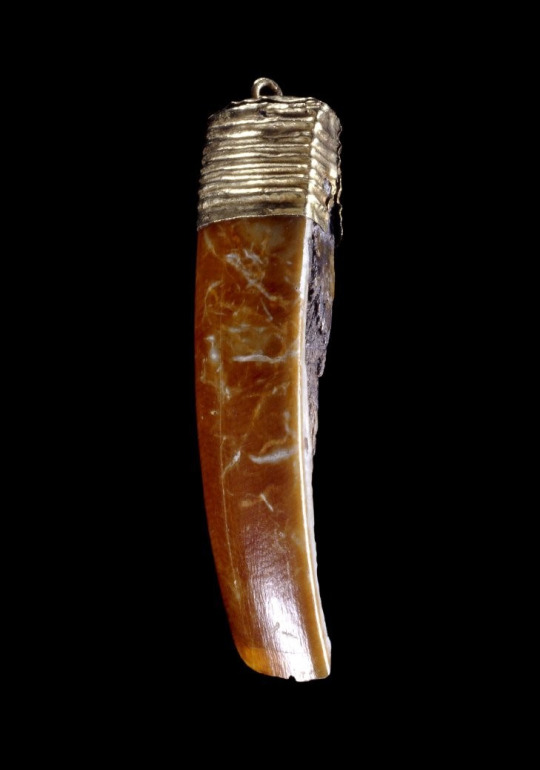
An Anglo-Saxon beaver tooth amulet discovered at the Wigber Low burial site in Derbyshire.
A 6th-century Anglo-Saxon riddle describes the beaver:
I am a dweller on the edge of steep stream banks, and not lazy at all, but warlike with the weapons of my mouth.
I sustain my life with hard labour, laying low huge trees with my hooked axes.
I dive into water, where the fish swim, and immerse my own head, wetting it in the watery surge.
The wounds of sinews and limbs foul of gore I can cure. I destroy pestilence and the deadly plague. I eat the bitter and well-gnawed bark of trees.
The Eurasian Beaver was hunted to extinction in Britain by the 16th century; since 2009, there has been an ongoing project to reintroduce them in Scotland.
#no idea there'd ever been beaver in Europe#no wonder they were so stoked to find more to kill in the New World#shiny objects#anglo-saxons#archaeology
460 notes
·
View notes
Text

Warrior and Rhea situationship knight yuri.
#these 2 are part of my indigo star worldbuilding#long ago. i decided my continents gonna have 3 more separate stories in addition to Colbalt's story#theres 4 of them in total. each taking place in one of the 4 regions of the continent. this is so i can explore more of its lore#Colbalts is about vengeance against a tyrant king. Warrior's is about doing archaeology and finding the horrors#more ocs! yippee!#wikipedia list of plants with symbolism once again my crutch#worldbuilding#art#fantasy art#my art#artwork#my artwork#digital art#illustration#knights#yuri#wlw#lesbian#dreamerx86
44 notes
·
View notes
Note
So I told a friend about the “we haven’t taken in situ photos yet” comic. But I cannot for the life of me find it. Do you mayhaps have it saved or know who posted it. (I mean the one where a skeleton comes back to life on a dig)
Here it is :)
-Reid
42 notes
·
View notes
Text

Archaeologists Find Statue of the Roman Sea God Triton in Mausoleum
Archaeologists have uncovered a Roman Statue of Triton during excavations in preparation for a housing development in Kent, England.
Archaeologists from the Canterbury Archaeological Trust (CAT) have discovered artifacts, including a mausoleum which is to be buried within a roundabout, which are more than 1,700 years old during an investigative dig related to a new housing development close to London Road in Teynham.
Robert Masefield, Director for RPS, said: “We expected interesting Roman archaeology, perhaps a cemetery, but the finds including the lively and unique statue of a Triton and the mausoleum remains have by far exceeded that. These finds are now part of Teynham’s local legacy and the nations rich Roman story. Further study will place the findings in their full historical context.”
The area, which is being built on by Moat Homes and Chartway Partnerships Group for its Frognal Lane development, follows the ancient Roman Watling Street and during an initial site evaluation, fragments of chalk wall foundations and Roman cremation burials were discovered. As a result, Swale Council, with advice from Kent County Council Heritage Conservation, required a 0.5-hectare archaeological excavation at the site.

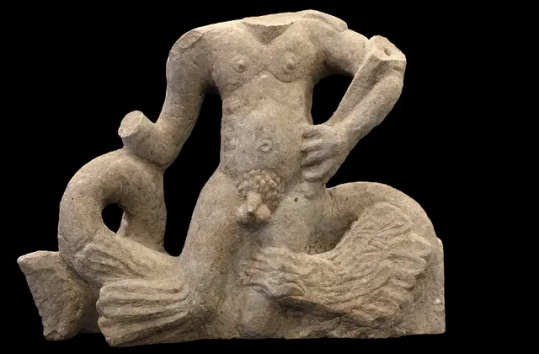

The Canterbury Archaeological Trust (CAT) was tasked with leading the dig, which revealed elements of a 30m square walled enclosure surrounding a c.7m square structure. Further excavations revealed that the structure is a Roman mausoleum containing a Roman coin dating from around 320 to 330 AD. The site also included Roman, and possibly later, burials with various grave goods.
However, the highlight of the findings was the discovery of a stone statue, representing the sea god Triton.
The Triton statue is substantial, appropriately 70cm (27.5 inches tall) and 70cm wide. It weighs more than 132lb (60kg). Archaeologists did not need to dig far. It was only 1.3 feet (40cm) below ground.
In Roman mythology, Triton was the son of Neptune, the god of the sea. The unique stone statue depicts Triton – a merman with the torso of a man and the tail of a fish – riding on a sea monster.
As a demi-god, he could calm the waves by blowing on his conch shell, which he appears to be holding in the uncovered sculpture. That part has been broken off, but the artifact is otherwise in incredible condition. It was carved between the late first century and second century AD.
Dr. Richard Hobbs, senior curator of Roman Britain at the British Museum, told MailOnline it is ‘spectacular’.
He said that, although a few fragments of Triton sculptures are known from Roman Britain, ‘nothing quite like this has been discovered before’.
Excavations are continuing at the site.
By Leman Altuntaş.
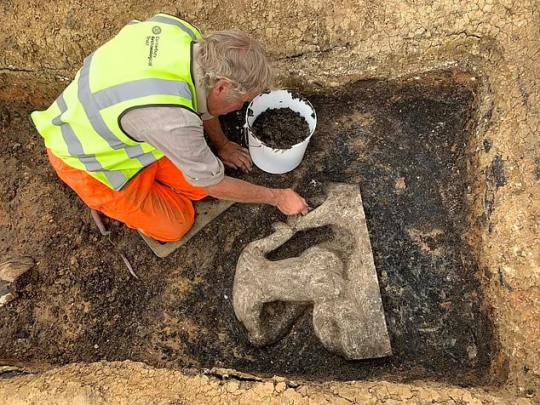
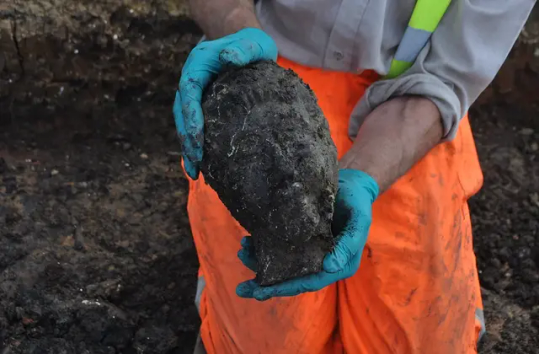

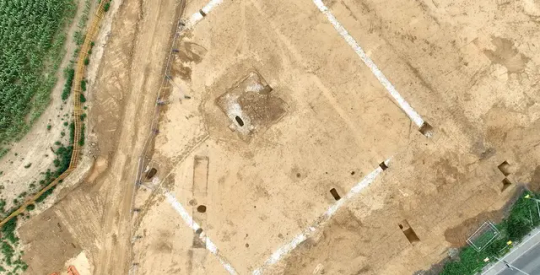
#Archaeologists Find Statue of the Roman Sea God Triton in Mausoleum#Kent England#The Canterbury Archaeological Trust#stone statue#roman statue#ancient tomb#ancient grave#ancient mausoleum#ancient artifacts#archeology#archeolgst#history#history news#ancient history#ancient culture#ancient civilizations#roman history#roman empire#roman art
222 notes
·
View notes
Photo

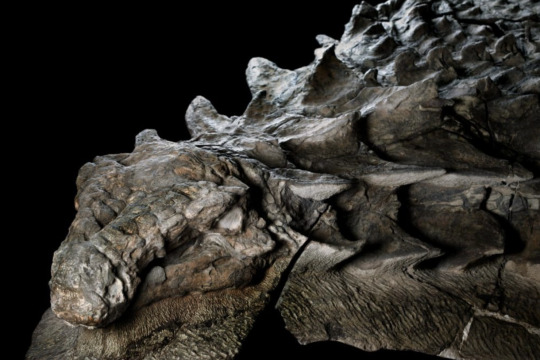
Discovered in a mine in Alberta, Canada in 2011, a fossil of a nodosaur dinosaur is one of the most well-preserved fossils of its kind, down to its skin, scales and even the contents of its stomach. These heavily-armored herbivores walked the Earth between the Late Jurassic and Late Cretaceous periods, with this particular specimen dating back 110 million years.
Considered one of the major archeological finds from the last decade, the nodosaur is currently on display at the Royal Tyrrell Museum in Alberta, Canada
#nodosaur#dinosaurs#dinosaur fossil#major archaeological find#dinosaur fossils#Royal Tyrrell Museum dinosaur finds#dinosaur museum in Alberta#Canada#archeology#archeological discoveries#mummified dinosaur
535 notes
·
View notes
Text
Here's a closer look at that sword's grip:

Here are more museum swords:


Here's a reproduction from Wulflund:


...one from Bronze Age Warrior...


...and one of my own from long-defunct Lancaster's Armourie:


They're not identical by any means, but there's a similarity - a "house style", maybe? - which makes me wonder if the new find and the swords on which the repros were based all originated from the same region (Central Europe, I think).
There was a lot of trading to and fro in the Bronze Age, and it wouldn't be too much of a stretch to think of basic-design swords like mine being shipped all over Europe then upgraded at point of sale with incised or hammered patterns as per local preference.
Is this too much imagination, not enough fact?
Maybe. But I know which I like... :->
326 notes
·
View notes
Text
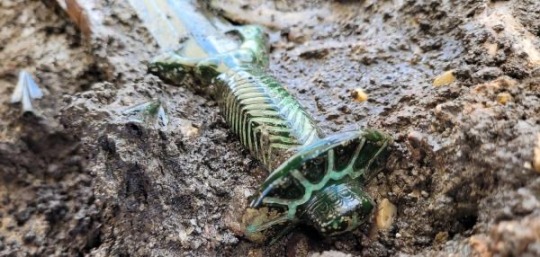
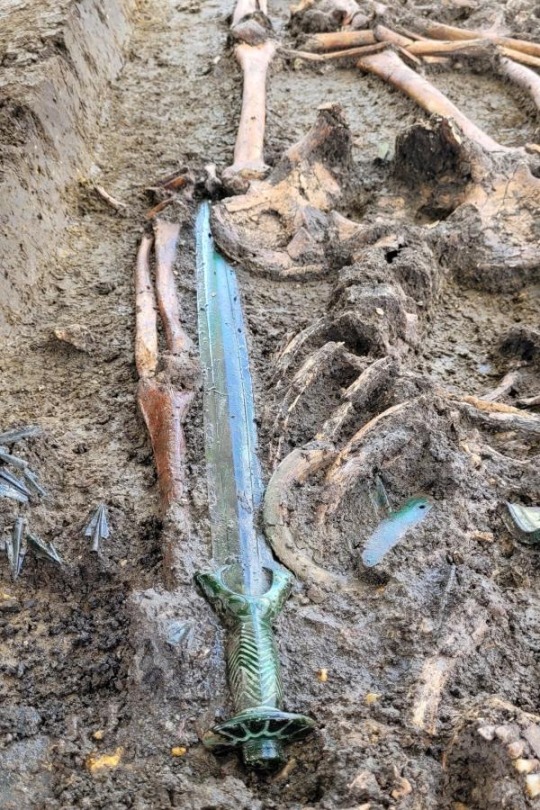
have y’all seen this bronze age sword they just found in germany that’s practically in mint condition btw???
#(article is in German)#archaeology#germany#I am in awe#just#can you imagine being the team to find this
212 notes
·
View notes
Text

love, in context B24-16 G, M/M, ~12,000/? words, 3/4 chapters
There’s a boy leaning against the fence. He’s putting most of his weight on it, arms propped up by their elbows and staring with rapt interest at the excavations. It’s been half an hour, now, and he hasn’t moved an inch. If he hadn’t been otherwise preoccupied with delicately troweling between third-century cobblestones, Edwin might have worried about the boy’s mental state. As it was, he’d been studiously ignoring the way he can feel eyes tracking his every movement. He thinks he’s been quite successful, so far. or: archaeology student Edwin Payne didn't expect the chatty tourist at the excavation fence to become someone he couldn't imagine life without
Chapter 3: ~5,700 words
in which there's rain on the excavations, impromptu museum dates, and a dramatic ending--or, this fic grew a plot and i'm so, so sorry
oops, it got serious and I made an actual promo post for this fic. if you like modern AUs of the ghost boys in very niche situations, you might enjoy me sticking them in some archaeological excavations based quite heavily on ones I've done myself. This fic keeps demanding each chapter be longer than the one previous and at this rate I'm fairly certain the next one will be about 8k. send help.
#lucy's thoughts#my writing#dead boy detectives#payneland#dbda#dead boy detectives fanfic#dbda fic#throws this out there into the void and runs away#yes! this photo is one i took myself of a wall i excavated! it was pretty cool!#unfortunately archaeological excavations look really boring in pictures#so you will just have to trust me (which. why would you do that. i find walls exciting to excavate)
28 notes
·
View notes
Text
Important discovery in Crete: in the region of Kasteli a large structure has been unearthed, estimations initially were that it was a Minoan phryctoria, however the latest hypotheses support it is likely a proto-Minoan shrine (earlier than the Palace of Knossos) dating back to about 3200/3000 BCE.
There are problems with the treatment of the archaeological site because it was found too close to the airport for its safety.
The unearthing of the monument is under process.
Source
#greece#europe#news#crete#kasteli#Heraklion#greek islands#Minoan civilization#archaeological finds#Greek news#Greek facts
33 notes
·
View notes
Text
every time I see people talking about post-canon one piece and about how the strawhats all go their separate ways it makes me want to start climbing walls and gnawing on the plaster!!!! what do you Mean the found family is going to split up... what do you mean they don't sail together forever... how else are they supposed to satisfy that itch under their skin... who else is meant to understand them... who else has seen their most agonizing moments and their best victories...
#to me they sail together forever okay#they go on a tour to visit everyone and kaya comes to apprentice under chopper#they're known to kidnap former friends and take them on adventures#the world is so big i refuse to believe that its only gonna take a year or so to travel by boat#maybe Sanji finds the all blue and stays there for a year and comes back#nami wants to map the whole world right. they've only gone to like twenty islands thus far#i can totally see robin staying on to travel for her archaeology#franky will follow his ship (and robin)#cant really picture brook leaving either after being alone for so long#obviously zoro isn't really location sensitive#i just think they all have this restless itch under their skin for the next several decades that only adventure can scratch#one piece#one piece nami#cat burglar nami#vinsmoke sanji#black leg sanji#roronoa zoro#usopp#franky one piece#nico robin#tony tony chopper#straw hat pirates#monkey d. luffy#brook one piece
116 notes
·
View notes
Text

Palaeolithic people had “worked” the sandstone in a way that mirrored the female form, and opened fractures for infiltrating water into the sandstone that nourished an outflow at the base of the pelvic triangle.
Cave pussy cave pussy!
Source
#the article isn't about the cave pussy#i just had to find it#paleontology#archaeology#paleolithic#cave art
14 notes
·
View notes
Note
Imo canon aemond has no interest in Helaena beyond the fact that he deserves to be the first born and thus she should belong to him. She is just an object.
like that’s his sister and he clearly cares about her a little but the main thing for him really does seem to be that it’s not fair that aegon gets given her because it’s also not fair he’s going to get given the crown when aemond thinks it should be him. Aemond’s “if we were betrothed i would treat her well as befits our house” to aegon in the show doesn’t read as much as an “i care about helaena’s specific well being” as it does an “i would be a better king than you and would respect the trappings of power which includes our sister” yknow. like that didn’t read to me as romantic interest at all
#i have gotten like 60 anons in 2 days for whatever reason i had to do archaeology to find this one to say. yeah#hotd
113 notes
·
View notes
Note
I am sliding into your inbox to ask you about historically multicultural australia 👀 what’s one fact/event/etc no one’s asked about yet that you think makes a good story?
I have a million and one ideas for things that no one has asked about that i think are terribly underrated. But I'll roll with a definitely not unknown, but definitely brushed over, simple answer of the topic of "afghan cameleers" in Australia.
While theyre often called "Afghan" in Australian history, they actually came from a variety of countries throughout the Middle East and south Asia. They were predomanently Muslim men, some bringing their families, although other religious minorities did also exist.
The Cameleers, (and their camels) were first brought over to Australia in 1838, although in no form of high numbers until 1858 when they were involved in the Bourke and Wills exploration of the east coast states. As a British colony, there were various high level people in Australia who were aware (from interactions with India and the Middle East primarily) of the benefits of camels in dealing with desert climates.
For over 50 years, camel trains became the primary form of transporting pastoral goods across much of the rural parts of Australia, at the hands of very experienced Cameleers. As a result of this, there was historically a number of towns which became known as "little Asia"s, "little Afghanistan"s or "Ghantowns".

Many of these men are coming to be recognised in modern times as fundamental actors in Australia's modern history. They also married Aboriginal, Chinese, or European women, and often, despite racial and cultural descrimination, became well respected members of local towns, playing important roles in their developments. Many of the men continued to travel back and forth from their home-countries, conducting business on an international scale. At the peak of employment, it is believed that 2000-4000 cameleers were employed in Australia, however recording of this immigration at this time is limited, and it is possible the numbers may have been higher.
However, when Australia introduced the Immigration Restriction Act 1901 (otherwise known as the "White Australia Policy"), many of these men found they were unable to become naturalised citizens of the newly-federated country, and thus unable to return to the communities (and families) that had become their homes. The remaining "afghan" communities dwindled after this. With the increase of railway access to Australia, the need for skilled cameleers died out, and the once valued workers became subject to a lack of employment, and increasing government and community persecution. Much of the men that remained into this time chose to return to their home-countries.
However, some communities remained. The town of Marree in South Australia is the location of the first Mosque in Australia, and is recognised as the longest surviving "Ghan-town" community, and the location of many descendant families. These workers, and their descendants, are also responsible for the construction of Australia's oldest permanent mosque, the Central Adelaide Mosque.

In recent times Australia is beginning to acknowledge important role these men made in the country's modern history, although they are subject to limited discussion, research, and archaeological recognition. And there is still a way to go, especially in making sure that the surviving archaeological sites relating to these communities and workers aren't lost.
#this was such a fun ask#even if it took me forever to get to it#If anyone wants actual references lmk#or just info in general#i wrote most of it from memory so I'll have to go find where my files are saved#but somewhere i have books and journal articles and stuff saved#the benefits of writing a thesis on multicultural heritage#i swear i have sources on everything#in a disorganised file#somewhere#history#Australia#mice answers things#archaeology#they let a mouse do archaeology?
51 notes
·
View notes
Text

Roman Emperor Hadrian Coin Found at Carlisle Archaeological Dig
A LOCAL metal detectorist has unearthed a unique Roman coin displaying Emperor Hadrian whilst at Carlisle’s Roman Bathhouse dig site in the Cricket Club grounds.
he coin, part of the Uncovering Roman Carlisle project, is said to be one of the most significant of the coins found by the team of archaeologists and volunteers, known as The Diggers.
The coin features Emperor Hadrian, who reigned from AD 117 to 138 and ordered the construction of the nearby Hadrian's Wall.
The reverse side depicts Fortuna, the Roman goddess of chance, fate, and fortune.
Dan Bell, from Carlisle, who has been metal detecting for four years and involved in the archaeological dig site for the past two years, made the discovery.
"I just thought it was your average Roman coin," Dan said.
"They've found many in better condition, but because of what is on it, it's special.
"Frank (Wardell), who organises the digs, thinks it’s the best one we’ve found so far."
Despite finding numerous medieval coins from the reigns of Edward I, Elizabeth I, and Charles I, Roman coins have been much rarer in his collection.
"The only Roman ones have been at the bathhouse," Dan said.
One commenter on social media indicated the coin was a 'sestertius', saying four of these were equivalent to a day's pay for a Roman soldier.
The coin adds to more than 4,000 significant finds at the site, including more than 700 Roman coins, painted wall plaster, military artefacts like arrowheads and spear tips, over 400 hairpins, imperial stamped tiles, North African-style roof tubes, glass beads, gaming pieces, and a rare Roman doll’s foot.
By Paul McTaggart.


#Roman Emperor Hadrian Coin Found at Carlisle Archaeological Dig#Emperor Hadrian#Carlisle’s Roman Bathhouse dig#coins#collectable coins#roman coin#metal detecting#metal detecting finds#ancient artifacts#archeology#archeolgst#history#history news#ancient history#ancient culture#ancient civilizations#roman history#roman empire#roman emperor
33 notes
·
View notes